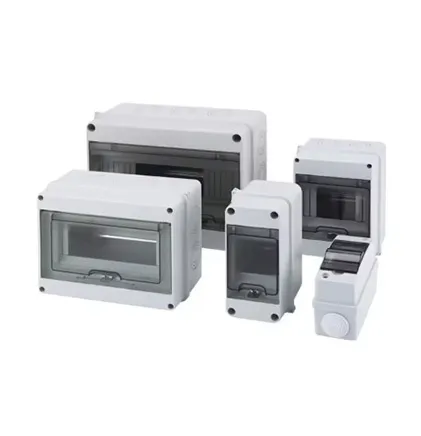
Does the Distribution Box Door Need Grounding? Safety Standards FAQ

Hey there! If you've ever found yourself scratching your head over whether that metal door on your distribution cabinet really needs a grounding wire, you're not alone. In factories, construction sites, and even commercial buildings, this question pops up all the time. Your boss might insist on it, while your instincts scream, "But the cabinet body’s already grounded!" Today, we're diving deep into this electrical conundrum, unpacking critical NEC standards, and answering your burning questions with real-world context.
We'll blend insights from field experiences and code requirements to give you clarity you can actually apply—no technical jargon fluff.
The Core Question: Grounding the Cabinet Door
1. Why ground the door if the cabinet body’s already grounded?
Imagine this scenario: You’re racing to finish wiring up a production line. The cabinet’s body is securely grounded, and you’re ready to power up. Then your supervisor walks by and points at the ungrounded door— "Add a wire to that!" Ugh.
Here’s why it matters:
- Static discharge: Metal doors can build up static charge, especially in high-voltage environments. A floating door can zap a worker, even if the cabinet body is grounded.
- Fault currents: If a loose wire inside touches the door accidentally, that door becomes live . Without grounding, anyone touching it becomes the path to earth—and gets shocked (or worse).
- NEC 250.148 doesn’t play favorites: The code mandates that all metallic parts of electrical boxes must bond to ground—no exceptions for cabinet doors.
Bottom line: That door is part of the enclosure . Skip the grounding, and you’re gambling with safety.
What NEC Standards Say About Electrical Box Grounding
2. Which NEC rules apply to electrical cabinet doors?
Let's unpack a few key standards that apply:
- NEC 250.148 (Grounding Conductor): Requires metallic junction boxes—and by extension, cabinet doors—to bond to ground using a designated grounding screw or clip.
- NEC 314.28 (Box Materials): Metal boxes (like your cabinet) must be reliably grounded and bonded, period.
- NEC 110.26 (Clearance Requirements): Ensures workers can safely access equipment doors without obstructions—no cramming wires around hinges!
Ignoring these isn’t just risky—it’s a code violation waiting to bite during inspections.
3. How do materials impact grounding?
Whether you're dealing with stainless steel or aluminum, the principle’s the same:
- Metal doors: Always require bonding . Use a dedicated green grounding screw (no piggybacking on mounting bolts!).
- Non-metallic (PVC/composite) doors: Typically don’t need grounding—but check for metallic frames or hinges.
Fun fact: NEC 314.15 warns against UV-degraded plastic boxes. Moisture + degraded materials = unseen risks. Stick to NEC-rated boxes, folks.
Grounding Methods: Doing It Right
4. What’s the proper way to ground a cabinet door?
Here’s your no-nonsense checklist:
- Choose a dedicated grounding screw or clip —not a reused bolt or hinge.
- Run a separate copper wire (usually 12 AWG) from the door to the cabinet’s grounding bar. Keep it snug but not stretched.
- Never daisy-chain doors: Each door gets its own ground wire. Series connections? That's a big NEC no-no.
Field tip: If your cabinet door opens frequently (like for maintenance), use a flexible braided ground strap to avoid wire fatigue.
5. What about hazardous locations?
Oh, this gets serious fast. Places like chemical plants or grain silos (Class I/II zones) demand more:
- Explosion-proof enclosures need factory-sealed grounding paths. Don’t retrofit holes—you’ll void the rating!
- Double down on seals: Conduit entries must block gas/dust ingress. Use NEC-approved sealants.
Translation: In volatile zones, grounding isn’t just recommended—it’s life-saving armor. Skip it? You risk a spark-fueled catastrophe.
Common Myths & Missteps
6. "It’s just a door—how dangerous can it be?"
Famous last words, right? The reality:
- Shock hazard: A worker leaning against a live metal door won’t see it coming—especially with sweaty gloves or wet floors.
- Arcing risks: Ungrounded doors floating near live terminals? That’s an arc-flash waiting to ignite. Remember—NEC’s rules target prevention, not hindsight .
Quote from a site engineer: "We found 480V potential on an ungrounded door after a wire frayed. Grounding costs pennies—hospital bills cost millions."
7. "Can’t I ground the door to the hinge?"
Short answer: Nope.
Hinges paint, corrode, or loosen over time—and then? Your grounding path vanishes. NEC demands intentional , low-resistance bonds. Screwing into bare metal with a grounding clip? Yes. Trusting rusty hinges? Code-violation chaos.
Beyond Grounding: Holistic Safety
8. What other NEC box standards matter?
Grounding’s vital, but don’t ignore these:
- Box sizing (NEC 314.16): Crowded wires heat up. Bigger boxes handle heat dissipation safely.
- GFCI/AFCI backup (NEC 210.8 & 210.12): Kitchens, bathrooms, and outdoor boxes need these shock/fire interrupters.
- Hazardous-location boxes (NEC 370-29): Sealed for gas/dust? Labelled? Keep your eyes peeled.
Think: Grounding + GFCI = Your dynamic duo against electrical surprises.
Final Word: Why This Isn't Just Paperwork
Grounding a distribution cabinet door might feel like tedious "box-ticking," but remember—it’s about people. That wire ensures no voltage lurks where hands touch . Whether it’s a plant engineer doing maintenance or a janitor cleaning nearby, grounding bridges the gap between "code compliant" and "life protected."
Safety regulations aren't barriers; they’re guardrails.
Tags:
Recommend Products











